2016 Nest Cam News
News from the 2016 Forsythe NWR Osprey Cam. Three young were produced this year.
August 8
Well, we are getting to see what this time of year looks like... Occasionally the nest is empty. This is good! It means that the young are off and learning how to soar, hunt and live on their own. The female has been absent lately and is most likely glad to be relieved of her parental duties. She will begin her migration south this month. She is followed by the juveniles and then the male will head south. Most of our birds winter in N. South America.
It's a great time of year to get out to watch ospreys. Now the size of the population is huge. Each year the nesting colony in NJ produces around 600-700 young/year so all these new recruits are flying around and are learning the skills they need to survive. A good spot to see young ospreys fishing is at the beach. Go in the early morning hours to watch them foraging in the surf for fluke and even bunker off shore.
In other news, we were having some technical issues with our streaming host and have setup the stream on another host to keep the stream online for the rest of the year at Edwin B. Forsythe NWR. I'd like to talk everyone who watches or has donated to support this camera! I'd also like to thank Jim Bowie for assisting us with the control of the camera and especially for moderating on our interaction page. I always like to join the conversation but it is hard for me to be super active with it at all times. He does a great job! Thanks, Jim!
July 22
 At seven weeks old, the young ospreys are the same size as an adult. Ready to fly, they jump and flap until they make their first flight.
At seven weeks old, the young ospreys are the same size as an adult. Ready to fly, they jump and flap until they make their first flight.
'Tis the season for a young ospreys first flight! The oldest of the brood is seven weeks old. The other two are only days younger in age. The time for us to be worried about their fate has faded. A brood of this size shows how experienced the male at this nest is. Three young at a nest is somewhat rare. Overall throughout New Jersey most nests produce 1-2 young, with an occasional 3 (sometimes even 4) at nests with older, more experienced adults. It is good to see this pair be so successful as only half of all young osprey produced will survive to reach adulthood. We need pairs to be productive as possible since young ospreys face many threats throughout their life, especially during their first year. We hope these young birds live a long and fruitful life and return to New Jersey to breed and help keep our population at a sustainable level.
June 28
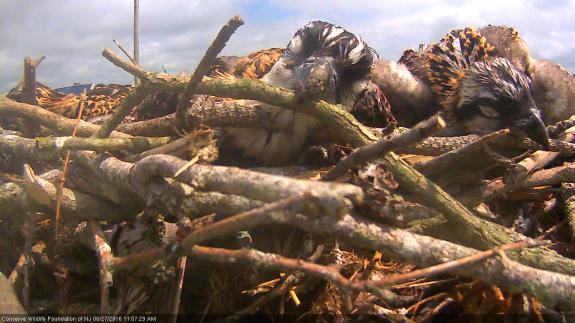 The 32 day old nestlings nap along the edge of the nest.
The 32 day old nestlings nap along the edge of the nest.
By now, our concerns over the survival of the runt (now 28 days old) has subsided. It has endured with a plentiful supply of food by the adult male. During this time in their development the young are growing very quickly. As their feathers continue to emerge from pin they are looking more and more like their parents. The overall buff coloration helps conceal them from aerial predators, like bald eagles and great horned owls, when they lay low in the nest.
At this time of year we are actively surveying many nests throughout the coastal region of New Jersey. These surveys have been conducted since the 1970s and are conducted to help determine the overall health of the state population. While visiting nests some young are banded for future tracking. While banding is not the primary goal of the project, it is still an important tool for biologists to learn more about their life history beyond New Jersey. We are tentatively planning to visit this nest on Thursday morning around 11am. Stay tuned for updates on our Facebook page.
June 13
I've heard that some viewers have been concerned about the overall health of the runt, who is now 14 days old. So far it seems that it is surviving just fine, however, things can change in an instant. It is natural selection for the oldest and most fit young to survive. In case this happens, here is our stance on intervening in removing the dying or dead young from the nest. In any situation that arises at the nest that is not human caused will be left to play out on its own. Just because we have a camera there does not give them any kind of special treatment other than us being able to watch over them, unlike hundreds of other nests. We WILL intervene if an adult or young is injured or entangled, which is a result of our human lifestyle. This is why we will never name any adults or young at this nest. We try not to anthropomorphize wildlife so they can remain wild.
June 7
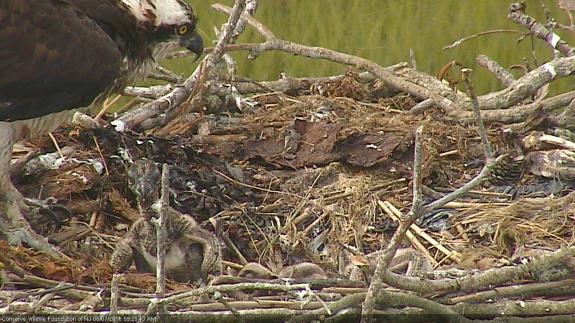 The oldest nestling is now 12 days old. At two weeks is when they start to look around and poke their heads up.
The oldest nestling is now 12 days old. At two weeks is when they start to look around and poke their heads up.
Well, time is just flying by. If you haven't seen, we now have three nestlings! The first egg hatched on May 26, the second on May 27, and the third on May 30.
The oldest is now 12 days old and its younger siblings are 11 days old and the runt is now 8 days old. I should mention that ospreys exhibit a natural adaptation that is referred to as "asynchronous hatching." This is where the adults start incubation at the onset of laying. The eggs hatch in the order they are laid and thus give the oldest the best chance of fledging. This adaptation allows for at least one very healthy osprey to be raised in times when there are shortages in prey availability. We will see the oldest lunge towards the food first and peck at its younger siblings to out compete them. Adults will never interfere with their young who battle each other, which is more often seen at nests where the male is not doing the best job by providing enough food for the entire brood. We have yet to see any siblicide at this nest and likely will not with this male. To carry on their genes, the adults primarily want the oldest and strongest young to survive.
May 24
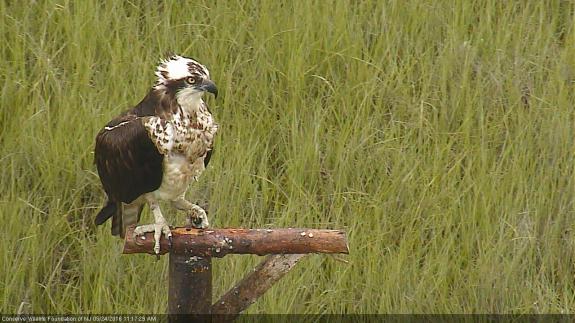 The female takes a break from incubating on day 37.
The female takes a break from incubating on day 37.
Day 37 of incubation is here. Hatch watch is on! So far this spring has been wet and cool. These are usually not good for ospreys, but it does look like the weather will trend to more seasonal temperatures this week with highs in the 80s. This is just the start of hatching at many nests throughout New Jersey, which is just in time for the start of the tourist season along the coast. As many people return to their summer vacation homes some will find that they might have ospreys who have built a nest on their house, boat or dock. It's important for everyone to know that nests, even those that do not contain eggs, cannot be removed without a permit. Those that do contain eggs or young are protected by both state and federal laws. To help give clear guidance on osprey nests and their removal in New Jersey we recently published "Living with Ospreys in New Jersey."
May 16
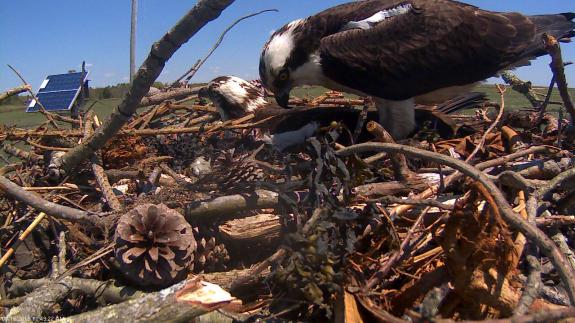 The view from the new pinhole cam!
The view from the new pinhole cam!
Thank you all for your patience! If we would have known that by hooking up a new pinhole camera would have caused the feed to be offline for 23 days then we would have NOT connected the camera. But, it is done and now streaming online.
Today is day 29 from when the first egg was laid on April 17. In New Jersery the average incubation time is around 36 days (next Monday for this nest). This pairs seems to incubate for a slightly longer period. In 2015 the first egg hatched on day 39 and in 2014 on day 39. Osprey eggs hatch in the order they are laid. Hatch watch begins on May 23rd.
Thank you to the US Fish and Wildlife staff for helping us get the new camera online!
April 25
While we all wait anxsiously for the network connection to be repaired, I figured that I could try and take the time to make a positive ID of both adults. In recent years researchers are using distintive features on birds to help identify individuals. With such great acvances in technology, we can now see things all over the world as they happen (and sometimes in HD!).
Let's start with the female, since she should be easiest.
 Comparison of 2015 and 2016 female.
Comparison of 2015 and 2016 female.
She has very distint plumage on her breast (bold necklace of brown feathers) and her head. Besides the big white patch above her left nostril, she has two spikes of brown plumage behind her eye on her eye stripe. I noticed this in almost all of the photos of her. I noticed it so much that when I looked at a couple other snapshots of another female on the osprey cam nest I knew that that was not the same female (she also had a lighter necklace of brown feathers on her breast). So, I think it's safe to say that we have the same female back and the same that's been here since 2013 when we first installed the camera.
I need to get a few more good photos of the male. Right now I am not 100% sure that it's the same one as last year...
April 21
Unfortunately, the network is down at Forsythe NWR. To connect the new pinhole camera we need USFWS IT to port forward (change settings) on the router in the Visitor Center. The IT staff could not access the router to make the changes. Upon trying to reset the router all of the previous setting have been wiped and we have now lost the live feed to the camera. This is unfortunate because we will now miss the tail end of egg laying. The new router is not scheduled to be installed until early next week (Tuesday-Wednesday) at the earliest.
I wish I could say that we could fix this but we can't. The network equipment there is not under our control. We will keep you all updated as to when we hope to get both cameras online. Thanks for your patience!
April 19
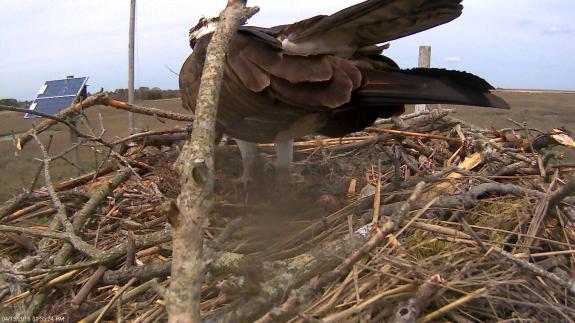 A view of the egg from the new pinhole camera.
A view of the egg from the new pinhole camera.
It's hard to believe that it's been almost a month since my past entry here. Sorry for the lack of posts. It has been a whirlwind of busy fieldwork for me over the past three weeks. Finally I am trying to catch up...
The pair has been straight down to business this year, which is a clear sign that this is the same pair. We are still collecting images of their heads to use to help make a more positive ID and to save for future research.
The first egg was laid around 12pm on April 17th. Last year the first egg was laid on April 16th and it hatched on May 26th. Hatch watch will begin during the week of 5/22 (Day 36). The second egg should "arrive" later today.
Otherwise, here is some great info that Camera Moderator, Jim B. posted to the Interact Page:
"The egg begins as an ovum within the ovary where it enlarges by a factor of 1,000 or more as the yolk is laid down a process that likely takes about 2 weeks. Upon maturation, the egg then takes about 24 hours to pass down the oviduct during which time albumen and membranes are added. The shell is added over about a 24 hour period in the uterus. - making the egg shell is very energy expensive for the female to produce an egg, this is the exhausting part, not as many think, sitting on the eggs after they have been laid.
So, the egg is laid approximately 2 to 3 days after being fertilized. It takes well over 2 weeks to form a single egg. The ovum is released by the follicle that encloses it and enters the upper portion of the oviduct. It is in this location that the egg is fertilized. Several ova are being formed simultaneously in the ovary in order to produce a clutch. If everything is in sequence, the second ovum is maturing and ready to be fertilized as the first egg is laid. Timing is important in breeding and the purpose of courtship is to bring the pair into synchrony. Although sperm may be viable within the oviduct for some time, likelihood of fertilization drops after a couple of days. Mating occurs multiple times over a 2 week period in order to raise the odds of fertilizing ova as they mature in sequence to form the clutch."
-- Dr. Bryan Watts of the Center for Conservation Biology.
March 25, 2016
Good morning, osprey fans! After much effort you can see that our efforts have paid off. Over the past couple weeks with the help a several great volunteers we were able to get the osprey cam installed right before the birds arrived back. Here's what we did:
- March 16 - we fixed the leaning nest, installed the components to get the sound working, installed new type 24 AGM batteries (2), installed the new pinhole camera system, and tested the PTZ camera to find that the network wire was bad.
- March 18 - a new network wire was installed and the PTZ camera was successfully re-installed.
- March 20 - both a male and female were seen perched on the nest. They both appeared to be "our birds" making this their 4th year at this nest.
- March 24 - the new pinhole camera was adjusted and the main PTZ camera pole was better braced. Some network changes were made to get the PTZ camera online around 5pm.
As you can see, just a little effort went into getting this feed back online... If you feel compelled, please make a donation to help support this camera system!
Both birds arrived back in the morning of March 20th. Right on schedule. What they're doing now is building up their nest and strengthening their pair bond, after being separated for the winter. The male will perform a courtship display called the "sky dance" where he does a high undulating flight over the nest while calling with a high pitch whistle to the female who is below and usually perched on the nest. We are hoping to get the pinhole camera online next week.
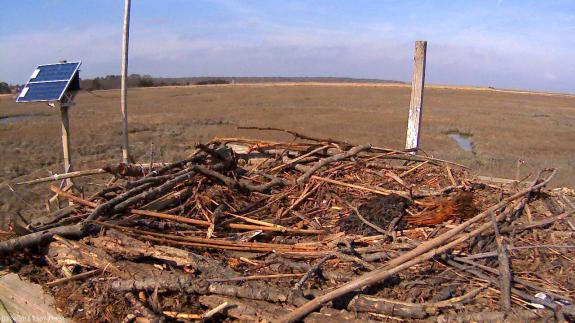 The new view from the pinhole camera.
The new view from the pinhole camera.
March 9, 2016
The camera and new batteries will be installed before April 1. Stay tuned for more updates!
Find Related Info: Osprey




